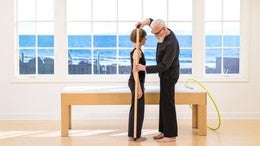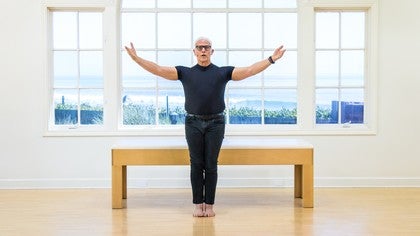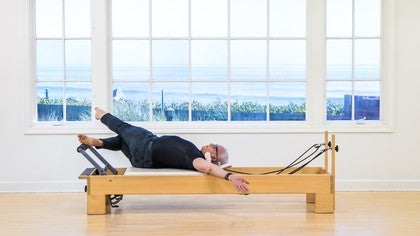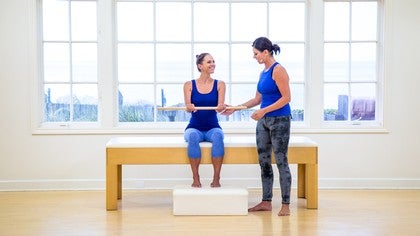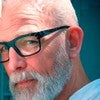Description
About This Video
Transcript
Read Full Transcript
I'm Ken Gilbert here at [inaudible] any time and want to play with a cue that I've been using for many years now. It's been evolving over the last five years, particularly in our theater company, drama dogs. I use a methodology of spine, body center and gesture and I realized that at this stage of my platas career, after these 20 plus years of teaching pilates that I have a way of dealing with vocabulary and the vocabulary is coming from my visual kinesthetic background into learning and teaching. What I want to do is when I'm reaching into the client based or the student based teaching, I want to play out on awareness of how does somebody walk and move systemically rather than appendicular. So there are people that walk appendicular, they're walking along, it's their legs and their feet, their arms in their hands and their heads kind of bobbing. Then in opposition there's the core movers, the people who are moving more through space from the sense of core. Also in work, many people will come in and say, I want to work on my core.
I don't know that people understand what core is. I think it's a personal decision or a personal experience. So as a tutorial today, I want to play with this idea of what is the core from my point of view, how do I play with it so that somebody is body centered? I'm working on several different books and projects and each one has its own lens on this core philosophy that I have. If you visit my website, it can Gilbert embodiment, you'll, you'll meet aesthetic anatomy, which is my philosophical and anatomy approach to how the body works. Also, other plots, anytime tutorials that I've done on midline plumb line on the five Halos or the four Halos of the core, I am right now playing with this idea that we have an opportunity to at at the age of 65, an opportunity to an age our brain and body connection by stimulating new patterns. Every time we we work or play or, or move sit, watch TV. So this year it's about letting go of habits and, uh, ordinary movement that is unconscious, perhaps reflexive or voluntary movement.
So I'm asking students to get involved with a lot of asymmetrical movement that involves, uh, that gets them involved in their bodies so that they're not thinking about their movement, they're moving their movement. I just realized that's the Fletcher Gesture Movement, the movement of their body. So this, this will continue into an idea of the five pointed star. So when I look at the whole body, we're like a Michelangelo Universal Man, and it's so that's not original. However, the way that I see people move into emotion, move into physical movement, move into thought is this idea of the five pointed star. And I call this the center core. This is the center of the star. All of my legs come into this part of my spine.
All of my arms move out and into this part of my spine. Then the neck is located between those two points of the front and the back. So if I look at that and feel that when I'm working into character on stage or I'm working with a client on the reformer of the Cadillac, that the chair, the spine corrector, or even the Peda Pole, I have an opportunity to see this five pointed star radiating out rather than disconnected or not quite realized in my discipline to work. Everything is about a pullup life is a pullup and when this five point is stars a pull up, then the body is centered and dynamic. Then we can [inaudible]. Using the vocabulary of Nia, we can reach out into flexibility.
We can reach in to strength. Out of flexibility is reaching out and lengthening bones and muscles. Opening joints. Strength is when we pull in and let them muscle hug the bone. Mobility is when everything is in constant motion. Stem and then stability is when things are on harmony and rest.
Agility is when I do stop start when I'm changing the direction of the movement and having to do things in in knots, so smooth away as mobility. It's in a way a culmination of all other of the previous four sensations. The five sensations of Nia. I'm interested in fives. I play in triads a lot. Body, mind, Spirit, uh, base, core, upper extremities. I play with fives. How do things balance into fives? Usually in a theater piece we have five chapters, five components in the body.
We have five stars are points of a star, fingertips, toes and crown of the head, so I want to introduce that idea and I will be applying it to several other tutorials on apparatus later. So for now, play with this idea that it's a notion of looking at the body differently. That's the aesthetic to look, to see how the body appears and then this we ground into the base. We have the [inaudible] of the feet, the ankles, the knees, the hips. We have the pelvis and that's the base of the body that defines that. That's the bottom part of all movement.
Then we have the core of the body which is using either roles, vocabulary, it's the pelvis, chest and head. How do those three body weights relate to each other or are they off balance? Are they in balance? Are they put in juxtaposition to each other or are they, they simply balanced in and radiating in the sense of center. Then of course we have the upper extremities and that's radiating out from the, the shoulder blades, the shoulder joint, elbows, wrists. Then we can get into the digits.
So that's the magical map of the 1320 natural times, 13 primary joints, 20 digits. So what I'm finding in my 20 plus almost 30 years in fitness, uh, how the I relate to the body is a dynamic. So this five pointed star is what I want to play with in every moment. Even if I'm relaxed and resting, I want to play with this idea that if there is an anatomical, if we go more esoteric and we're doing other disciplines, we'll go into the Hora. And that's an energetic center that is extraordinary. I'm moving up out of that and into a mechanical center, how I refer to the Mechanical Center.
So when we're looking at balance movement or asymmetrical movement, working with golfers, working with, with anybody, a tennis players, anybody who's doing one sided movement, there still is a sense of center. And core. So as we play with this radiate out and understand that we are doing a pull up out of gravity. When I went aerials for five years in our theater company, I learned that gravity sometimes goes up, that if I trusted the rope pulling me up, whether I was wearing a harness or hanging from ropes, that indeed I had a center that allowed me to play with gravity going that way. Otherwise I get too scared and I didn't ever fall down. I didn't ever injure myself.
I used the plots principles that I had and embraced through all of my practice to hold straps to be able to hang by one arm or to be hanging from the pelvis through a girdle of it allowed me to feel what that is like. So as we play with this, you'll see me work with this, not necessarily in vocabulary of words, but you can see that in other classes that I've taught in plots. Anytime how I'm activating this sense of five pointed star, the sense of five pointed star at the sense of five point of star, everything working from here, five pointed star. So this notion of the five pointed star having the muscles, the four muscles of the abdominals coming together at the pubis coming together at the bottom of the [inaudible] process. So we have the trans versus going this way.
We have the rectus abdominis going this way. We have the internal external beliefs going this way, internal, external going this way, we're taking care of last year for me it was about exploring the Serratus, the anterior, the posterior cereus, the QL in relationship to the SOS so that I can play with how my body moves connected to the core through the, so as this top of the, so as is connected to the back of the the center core. So let's play with that in all things that we do. So my model of teaching is simple that I need to use instruction to teach. Then I begin to, that's what to do, how to do it.
Then I teach the body that I'm teaching. How that body does that movement. So then that's the teaching. The ultimate lesson that I want to play with through this five pointed star is what is the education that is provided. So through the instruction the teaching begins and then the life education occurs. Live education, meaning I'm working out at a local hotel here in Santa Barbara, the Bacara is a very high end resort hotel. I'm meeting these people one-off, never will see them again in their life.
And I come in and say, there's one thing that will happen today is we're having this one off experience and if I can teach you something new about your body today, that will change your life because you can play with it, you can be educated by it. Then I've done my job as teacher and at first is a little bit of off put because most people are used to instruction. Maybe not even teaching, but definitely not necessarily the focus of education. Just last weekend I had a, a man who was concerned about his knee and I said, well good. He said, so let's just do arm work and some core work. And I said, what? We'll do his legs, and he said, oh, okay. I said, you have to trust me on this. So we did the classic midline stuff on the reformer with a prehensile, the zip up of the ankle bones above the knee, high inner thigh up into the core of the body and went into this work. He realized that he tends to fall out. Many men do their knees fall out, who he had just been on the bike for four, three days and realized that he had bothered his knees.
We got back into this two hours after our session, I got an email from him saying, thank you. My takeaway was that if I keep my kneecaps going forward, I have no pain. So that's education and that's what I say. If I can watch this five pointed star, regardless of the body skill and talent that I can play with any movement in any direction, any movement in any direction, we can play with all five joint actions of the spine. I covered that in another tutorial, which is forward flection coming from the center of the star extension coming from the center of the star rotation coming from the center of the Star circumduction coming from the center of the star side, bending coming from the center of the star. So there's many applications.
So I invite you to play with that notion that from the center of the center, as I call it, the center core, that you can radiate out, you can draw in, and there'll be no compromise to the systemic joints of the body. So thank you.
The Teacher's Corner: Teaching Tools
Comments
You need to be a subscriber to post a comment.
Please Log In or Create an Account to start your free trial.

